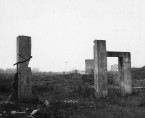Gleiwitz I
A sub-camp founded in March 1944 at the rolling stock repair yard in Gliwice (German: Gleiwitz). The first several score prisoners transferred from Auschwitz were sent to work assembling seven wooden residential barracks and a kitchen, hospital, storage area, and workshops. On the sides facing the road and the rail tracks, the sub-camp was screened by a wall of concrete slabs topped with barbed wire, and on the other sides there was barbed wire strung on concrete posts. Set up along the fence were eight wooden guard towers. The first director was SS-Hauptscharführer Otto Moll, who was seconded in May to Birkenau to oversee the destruction of the Hungarian Jews in the crematoria, and during that period the acting directors were SS-Oberscharführer Jansen and SS-Oberscharführer Richard Stolten.
The prisoners worked repairing damaged sides of cars, in the machine shop and smithy, and building roads and a nearby airstrip. From the late summer of 1944, they were taken out to work on two 12-hour shifts. Prisoners who for some reason had no other assignment were consigned by Moll to “Steinetragen”—the pointless carrying of stones from a nearby slag heap to the camp and back again.
Almost a hundred Gleiwitz I prisoners died as a result of mistreatment, hunger, and backbreaking labor. At least five were shot while trying to escape, and two Russians hanged for the same offense. The number sent to Birkenau after selection cannot be established. The sub-camp population just before evacuation in January 1945 was 1,336 prisoners, mostly Jews, Poles, and Russians. They were marched on foot to Gross-Rosen.
